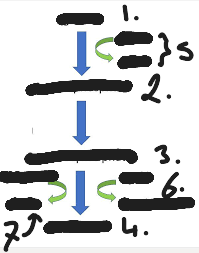Glycolysis
1/11
There's no tags or description
Looks like no tags are added yet.
Name | Mastery | Learn | Test | Matching | Spaced |
|---|
No study sessions yet.
12 Terms
where does it happen
cytoplasm
does it require oxygen
no
how does glucose enter the cell
Glucose and other hexose sugars enter cells from the tissue fluid by facilitated diffusion using a specific hexose carrier. This carrier can be controlled (gated) by hormones such as insulin, so that uptake of sugars can be regulated.

glucose
glucose phosphate
2x glycerate 3- phosphate
2xpyruvate
2xATP hydrolyses into 2x ADP +Pi
2xNAD reduced to 2xNADH
4xADP +Pi to 4xATP
step 1
The first step in glycolysis is the phosphorylation of the hexose to form hexose phosphate (usually glucose phosphate), using phosphate from ATP. 2 ATP are used after each has one phosphate removed they become ADP
why is the glucose phosphorylated
Firstly, it keeps glucose in the cell by effectively removing “pure” glucose, so glucose will always diffuse down its concentration gradient from the tissue fluid into the cell (glucose phosphate no longer fits the membrane carrier). Secondly, it “activates” glucose for biosynthesis reactions: glucose phosphate is the starting material for the synthesis of pentose sugars (and therefore nucleotides and DNA), glycogen and starch
step 2
next the glucose splits as its unstable into 2 glycerate 3 phosphate
step 3
GP or glycerate 3 phosphate is oxidised by removing a hydrogen to from pryuvate. The hydrogens are accepted by the Co enzyme NAD which is now reduced. The oxidation releases energy which is able to convert 4 ADP +pi into 4 ATP. Pyruvate marks the end of glycolysis,
what is the number of ATP produced and the net from both GP
4 made net of 2
how many reduced NAD made per glucose
2
lab experiment is set up to investigate ATP production in isolated mitochondria. They suspended mitochondria in an isotonic solution and added ADP +Pi and a respiratory substrate oxygen was supplied through out . suggest why glucose shouldn’t be the respiratory substrate
glucose is used / Brocken down to pyruvate in the cytoplasm not the mitochondrial matrix glucose cannot cross the mitochondrial membrane / can not enter cytoplasm.
why should an isotonic solution be used in the experiment above.
to prevent osmosis/ net movement of water so that the mitochondria so they do not burst or shrivel